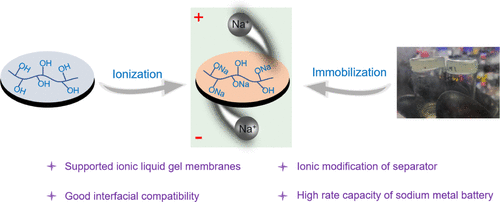当前位置:
X-MOL 学术
›
ACS Sustain. Chem. Eng.
›
论文详情
Our official English website, www.x-mol.net, welcomes your
feedback! (Note: you will need to create a separate account there.)
Supported Ionic Liquid Gel Membranes Enhanced by Ionization Modification for Sodium Metal Batteries
ACS Sustainable Chemistry & Engineering ( IF 7.1 ) Pub Date : 2021-08-30 , DOI: 10.1021/acssuschemeng.1c02983 Wenjie Xiong 1 , Zhuoheng Tu 1 , Zengyu Yin 1 , Xiaomin Zhang 1, 2 , Xingbang Hu 1, 2 , Youting Wu 1, 2
ACS Sustainable Chemistry & Engineering ( IF 7.1 ) Pub Date : 2021-08-30 , DOI: 10.1021/acssuschemeng.1c02983 Wenjie Xiong 1 , Zhuoheng Tu 1 , Zengyu Yin 1 , Xiaomin Zhang 1, 2 , Xingbang Hu 1, 2 , Youting Wu 1, 2
Affiliation

|
Sodium batteries are attractive alternatives to the rapidly emerging large-scale intermittent renewable energy storage devices due to their low production cost and abundant sodium resources. The electrochemical performances of sodium batteries are highly dependent on the compatibility and interface resistances between electrode materials and electrolytes. Herein, we develop a simple method to modify a glass fiber (GF) separator by interfacial ionization and in situ introduction of a sodium source into the separator for a sodium metal battery. Polyionic liquid/ionic liquid gels were synthesized to incorporate into modified GF separators to prepare supported ionic liquid gel membranes (SILGMs) as dual separators and electrolytes for sodium batteries. The sodium-ion transference number of ionogel electrolytes incorporated on the support with and without modification was measured. The electrochemical performance characteristics of the battery with and without GF modification were evaluated by cyclic voltammetry, galvanostatic charge–discharge tests, and cycling stability as well as the galvanostatic intermittent titration technique (GITT). It was found that the specific capacity of the sodium metal battery increased by more than 20% after modification at a relatively high current density. Surprisingly, the specific discharge capacity of the assembled sodium metal battery can reach 112 mAh·g–1 at 0.1 C, fairly close to the theoretical capacity of cathode materials. The specific capacity retention of the battery with the modified GF separator was up to 99% after 100 cycles at 1.0 C. This work presents a novel method for separator modification to alter the interface compatibility between electrode materials and electrolytes for sodium metal batteries and provides a new insight to improve battery performance.
中文翻译:

钠金属电池电离改性增强的负载型离子液体凝胶膜
钠电池由于其低生产成本和丰富的钠资源而成为快速兴起的大规模间歇性可再生能源存储设备的有吸引力的替代品。钠电池的电化学性能高度依赖于电极材料和电解质之间的相容性和界面电阻。在此,我们开发了一种简单的方法,通过界面电离和将钠源原位引入钠金属电池的隔膜来改性玻璃纤维 (GF) 隔膜。合成聚离子液体/离子液体凝胶以掺入改性的 GF 隔膜中,以制备负载型离子液体凝胶膜 (SILGM) 作为钠电池的双隔膜和电解质。测量了在经过和未经改性的情况下掺入到载体上的离子凝胶电解质的钠离子转移数。通过循环伏安法、恒电流充放电测试、循环稳定性以及恒电流间歇滴定技术 (GITT) 评估了有和没有 GF 改性的电池的电化学性能特性。结果发现,在较高的电流密度下改性后,钠金属电池的比容量提高了20%以上。令人惊讶的是,组装好的钠金属电池的比放电容量可以达到112 mAh·g 和循环稳定性以及恒电流间歇滴定技术 (GITT)。结果发现,在较高的电流密度下改性后,钠金属电池的比容量提高了20%以上。令人惊讶的是,组装好的钠金属电池的比放电容量可以达到112 mAh·g 和循环稳定性以及恒电流间歇滴定技术 (GITT)。结果发现,在较高的电流密度下改性后,钠金属电池的比容量提高了20%以上。令人惊讶的是,组装好的钠金属电池的比放电容量可以达到112 mAh·g–1在 0.1 C,非常接近正极材料的理论容量。使用改性 GF 隔膜的电池在 1.0 C 下循环 100 次后的比容量保持率高达 99%。这项工作提出了一种隔膜改性的新方法,以改变钠金属电池电极材料和电解质之间的界面相容性,并提供了提高电池性能的新见解。
更新日期:2021-09-13
中文翻译:

钠金属电池电离改性增强的负载型离子液体凝胶膜
钠电池由于其低生产成本和丰富的钠资源而成为快速兴起的大规模间歇性可再生能源存储设备的有吸引力的替代品。钠电池的电化学性能高度依赖于电极材料和电解质之间的相容性和界面电阻。在此,我们开发了一种简单的方法,通过界面电离和将钠源原位引入钠金属电池的隔膜来改性玻璃纤维 (GF) 隔膜。合成聚离子液体/离子液体凝胶以掺入改性的 GF 隔膜中,以制备负载型离子液体凝胶膜 (SILGM) 作为钠电池的双隔膜和电解质。测量了在经过和未经改性的情况下掺入到载体上的离子凝胶电解质的钠离子转移数。通过循环伏安法、恒电流充放电测试、循环稳定性以及恒电流间歇滴定技术 (GITT) 评估了有和没有 GF 改性的电池的电化学性能特性。结果发现,在较高的电流密度下改性后,钠金属电池的比容量提高了20%以上。令人惊讶的是,组装好的钠金属电池的比放电容量可以达到112 mAh·g 和循环稳定性以及恒电流间歇滴定技术 (GITT)。结果发现,在较高的电流密度下改性后,钠金属电池的比容量提高了20%以上。令人惊讶的是,组装好的钠金属电池的比放电容量可以达到112 mAh·g 和循环稳定性以及恒电流间歇滴定技术 (GITT)。结果发现,在较高的电流密度下改性后,钠金属电池的比容量提高了20%以上。令人惊讶的是,组装好的钠金属电池的比放电容量可以达到112 mAh·g–1在 0.1 C,非常接近正极材料的理论容量。使用改性 GF 隔膜的电池在 1.0 C 下循环 100 次后的比容量保持率高达 99%。这项工作提出了一种隔膜改性的新方法,以改变钠金属电池电极材料和电解质之间的界面相容性,并提供了提高电池性能的新见解。











































 京公网安备 11010802027423号
京公网安备 11010802027423号